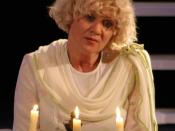The Glass Menagerie Tennessee Williams's play, The Glass Menagerie, is a story about Amanda, her son Tom, and her daughter Laura. Each character clings to his or her own dream world, each of which is so easily shattered as their illusions are destroyed by actuality. There are many symbols that Williams uses throughout the play in order to represent prominent themes. A few principal themes that Williams uses in his play are the unicorn which symbolizes Laura, The Homemaker's Companion which symbolizes Amanda's quest for romance in her life, and the magic scarf which not only symbolizes freedom for Laura, but also for Tom.
A symbol that is very prominent throughout the entire play is that of the glass unicorn. The unicorn is symbolic of Laura in many aspects. Although unicorns are very similar to horses, they possess a particular physical difference. Much like Laura is almost the same as other girls, but her physical handicap makes her feel inferior to other people.
Also, Laura is taken care of and sheltered by her family because there are many things that she is not able and does not want to do. This is comparable to the way that Laura shelters and protects her glass unicorn. When Jim breaks the unicorn and tells Laura of his engagement, it seems to take away all hope that Laura has of being like others. However, in giving the broken unicorn to Jim, Laura seems to begin to realize that she is not so different after all.
The Homemaker's Companion is a magazine filled with stories of romance that Amanda occasionally sells. Unfortunately, now that Amanda is quite old and has two older children, she cannot seem to find romance in her life. Although sometimes she does not realize it, Amanda's days filled with love and romance have passed her by. However, selling magazines symbolizes her way of exposing herself and her life to romance. Laura, however, is young and has not found a suitable husband or partner. Because of this, Amanda makes it one of her main objectives to find Laura an appropriate gentleman caller. Throughout the entire play, Amanda does not face reality about Laura's disability even though Tom desperately tries to explain it to her. This is evident when Tom is trying to get it through to Amanda that Laura is crippled. Amanda responds with "Don't say crippled! You know that I never allow that word to be used"(80). Nonetheless, when Laura's gentlemen caller, Jim tells the family of his engagement to another girl Amanda is stunned, and forced to face reality and admit that Laura is different. She begins to realize that she cannot turn Laura into something she is not.
Each character throughout the play is trying desperately to get away from something. Tom's escape from his job and from his life is the movies. He visits the movies every free moment that he has. One night while returning from one of his many trips to the movie theater, Tom is stopped by Laura at the front door. He is holding what he claims to be a magic scarf. He gives it to Laura while telling her that "you wave it over a goldfish bowl and they fly away canaries"(56). The magic scarf symbolizes freedom for not only Laura but also for Tom because by freeing Laura, Tom would eventually become free. Laura is seen as the goldfish in the goldfish bowl because she is stuck in her own little world and is seemingly going to be there forever. However, Tom wants her to grow, develop, and change in order to become free of the world in which she has trapped herself. The magic scarf symbolizes the way in which Laura could become free of the boundaries within which she is confined Throughout The Glass Menagerie, there are many instances in which Williams uses symbols to get across the themes of the play to the reader. The glass unicorn, Amanda's selling of The Homemaker's Companion, and the magic scarf that Tom gives to Laura are three symbols used predominantly throughout the book in order to try to help explain certain themes.





